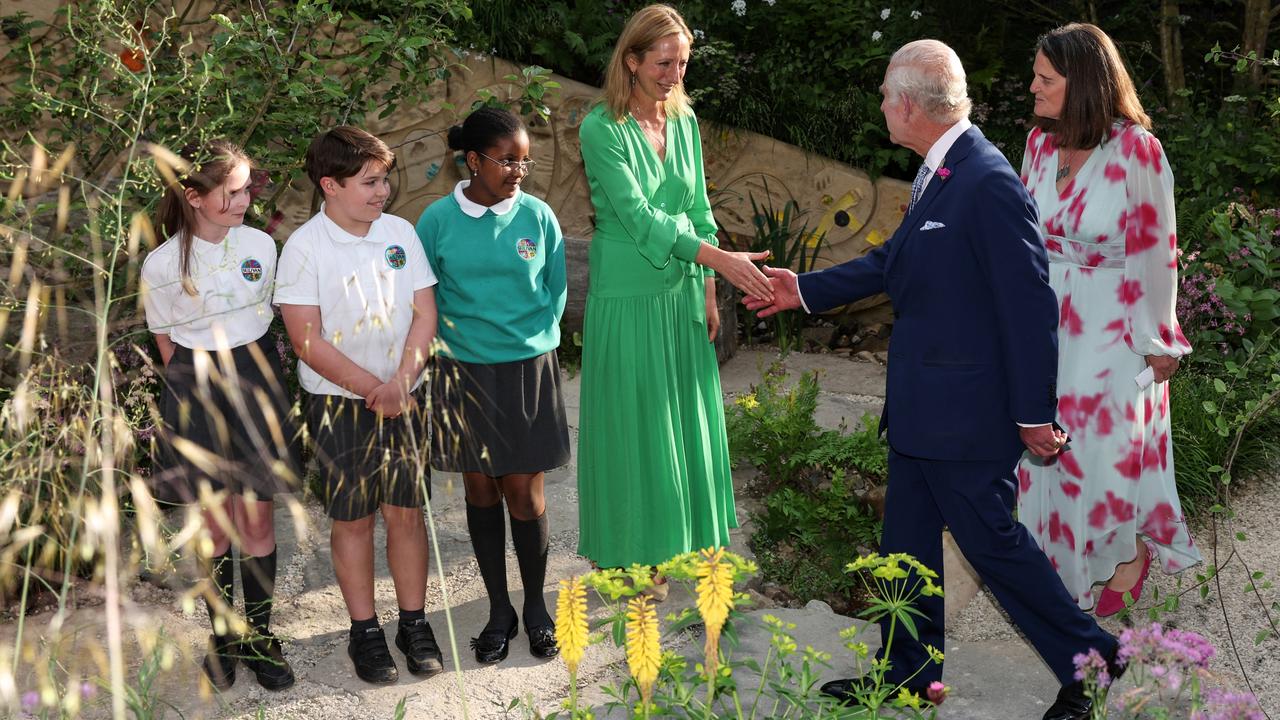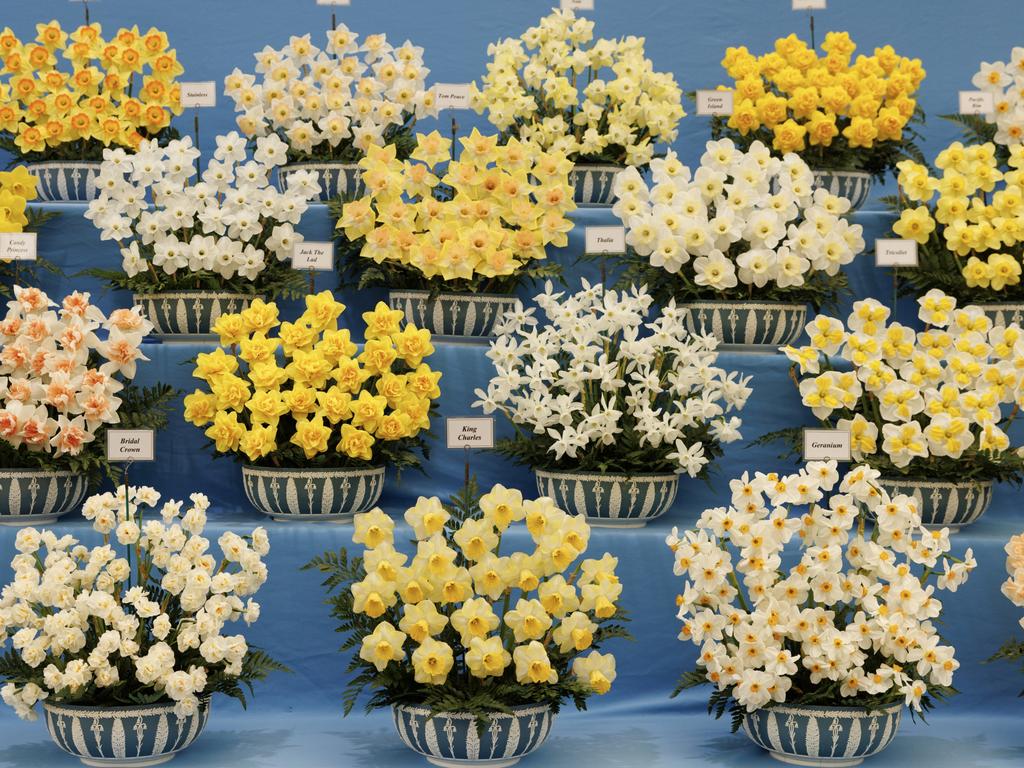First in history child-designed Chelsea garden visited by the King
Keen green thumb Charles III was renamed the ‘King of the Compost’ by cheeky young gardeners at London’s famed Chelsea Flower Show after they ‘banned’ grown ups from their garden

READING LEVEL: GREEN
King Charles was left in hysterics* after children at the RHS Chelsea Flower Show gave him the nickname “King of the Compost*”.
The schoolchildren gave the King a badge with his new nickname in honour of his environmental work, while Queen Camilla got a sweet as honey “Queen of the Bees” version.
The royals were being shown the No Adults Allowed Garden, designed by Harry Holding and children from Sulivan Primary School in London.

The garden is the first in the more than century-long history of the show to be designed by children.
The monarch*, an avid* gardener with a lifelong interest in the natural world and protecting the environment, greeted growers and designers at the annual event, which has been held in the grounds of the Royal Hospital Chelsea for the past 111 years.

HISTORY OF THE SOCIETY
Founded in 1804, the UK’s Royal Horticultural* Society (RHS) was originally named the Horticultural Society of London in a meeting of just seven men, including renowned* botanist* Sir Joseph Banks, who was aboard the Endeavour* with Captain James Cook* when it arrived at what is now Kamay/Botany Bay in 1770.
The Society’s aim was to introduce a scientific, evidence-based approach to horticulture and to share knowledge. But it was a gentlemen’s club in its early days – women were not allowed to join until 1830.
In 1913, the Society moved its annual Great Spring Show to the grounds of the Royal Hospital in Chelsea, where it has remained ever since, becoming the famous RHS Chelsea Flower Show.

ROYAL CONNECTIONS
In 1858 Prince Albert became the RHS president and from 1861 the Society got its Royal Charter* and a fashionable new garden.
Between 1861–1888 the main RHS garden sat in the heart of South Kensington, London, which today is the location of the Science Museum.
The first royal visit to an RHS show was in 1890 and attendance at RHS Chelsea has always been a cherished family event for the royals.
It was a tradition beloved by the late Queen Elizabeth II’s great grandmother Queen Alexandra and enjoyed by her grandparents King George V and Queen Mary.

As Princess Elizabeth, she attended the first post-war show in 1947 (the first for eight years) with her parents King George VI and Queen Elizabeth, the Queen Mother, both keen gardeners at the Royal Lodge.
Their love of horticulture has passed down the generations. The late Queen’s uncle Sir David Bowes Lyon was the Treasurer of the RHS from 1948 and the President from 1953-1961.
The late Queen Elizabeth II became the patron* of the RHS in 1952, on the death of her father, King George VI, carrying on the dynastic* association with the RHS, which had begun in Victorian times. She performed the role alongside the late Queen Elizabeth, the Queen Mother, who was patron of the RHS for 65 years.
King Charles III became the new RHS patron this year.
Source: The Royal Horticultural Society

WATCH THE VIDEO

POLL
GLOSSARY
- hysterics: a laughing fit
- compost: a mixture of decayed plants and vegetable waste added to soil to help plants grow
- monarch: a sovereign head of state, a king or queen who rules over a kingdom or empire
- avid: keen, enthusiastic, eager, having or showing a passion for something
- horticultural: relating to the study or activity of growing garden plants
- renowned: famous or very well known and regarded for something good
- botanist: scientist who studies plants
- the Endeavour: His Majesty’s Bark Endeavour (also known as HMS Endeavour) was the British Royal Navy research vessel that Captain James Cook and crew sailed during the epic 1768 to 1771 world voyage that brought them to Botany Bay in 1770
- Captain James Cook: British naval captain, navigator and explorer (1728-1779)
- patron: someone honoured as a special guardian or protector of something and often gives money and other support to that cause
- dynastic: a line or succession of rulers descending from the same family
EXTRA READING
Palace confirms King Charles has cancer
King Charles dumped from our $5 note
QUICK QUIZ
- What nicknames did the children give to King Charles III and his wife Queen Camilla?
- How long has the annual Chelsea Flower Show been running at the Royal Hospital Chelsea?
- Who Designed the No Adults Allowed Garden?
- How many other gardens at the show have been designed by children in its 111-year history?
- Botanist Sir Joseph Banks was a founding member of RHS but why do many Australians know about him?
LISTEN TO THIS STORY
CLASSROOM ACTIVITIES
1. No Adults Allowed school garden
Work with a partner to design and sketch your own “no adults allowed” garden space for your school. Take into account the space you have, the climate in your town and how to make it a sustainable and fun space for children at your school to explore and enjoy for many years to come.
Use the Chelsea garden show example for some inspiration.
Explain and display your garden to your classmates.
Time: allow 40 minutes to complete this activity
Curriculum Links: Visual Arts, Design and Technologies, Science, Personal and Social, Critical and Creative Thinking
2. Extension
What do you think the connection may be between the royal family’s love of horticulture and the Royal Horticultural Society (RHS) Chelsea Flower Show?
How did the royal connection help build the Chelsea Flower Show into one of the most significant horticulture events in the world?
Time: allow 10 minutes to complete this activity
Curriculum Links: English, Science, Personal and Social, Critical and Creative Thinking
VCOP ACTIVITY
Imaginative dialogue
Imagine you were there during the event being discussed in the article, or for the interview.
Create a conversation between two characters from the article – you may need or want to include yourself as one of the characters. Don’t forget to try to use facts and details from the article to help make your dialogue as realistic as possible.
Go through your writing and highlight any punctuation you have used in green. Make sure you carefully check the punctuation used for the dialogue and ensure you have opened and closed the speaking in the correct places.

